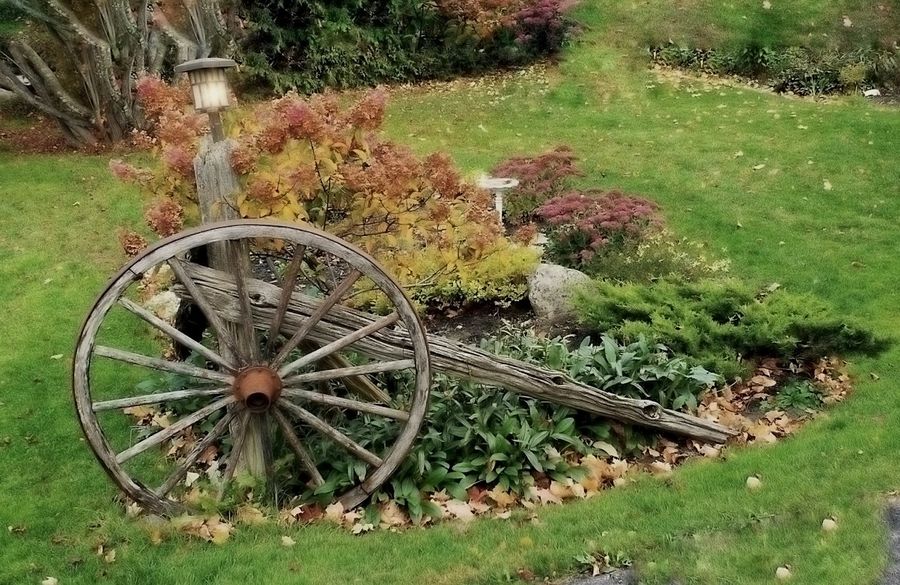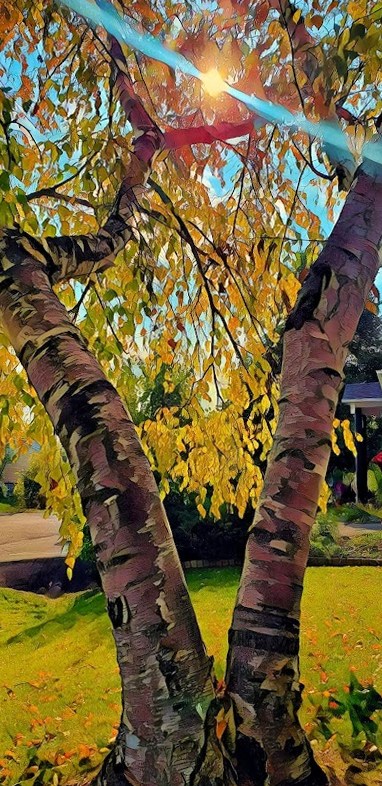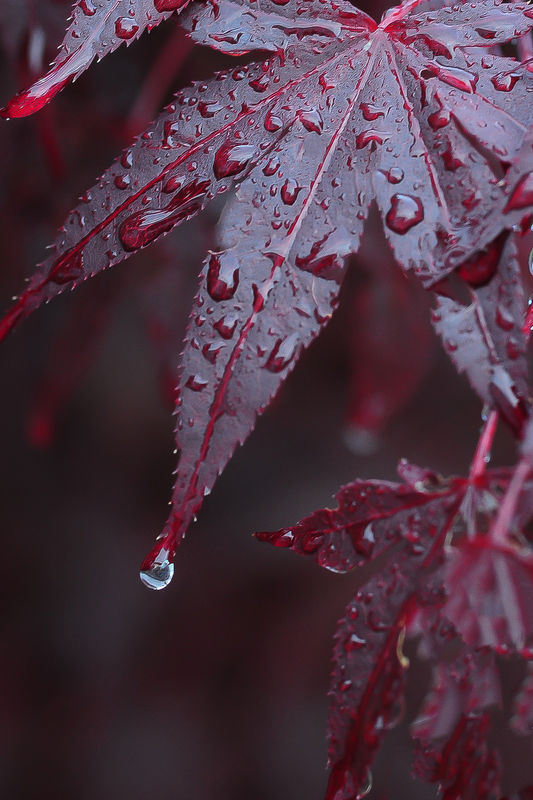Filters used for Fall Colors?
Sep 22, 2021 16:56:06 #
If you want to attempt to replicate the effects of a CPL filter in post-processing, I suppose, you could be somewhat successful but it might be tedious and not as effective in the end product. You can select specific areas or objects to intensify colour saturation, clone out unwanted reflections, and utilize many layers of work. To me, that seems to like a heck of a lot of work that could be addressed by a simple rotation of a filter.
This is not to suggest that a polarizing filter is a cure-all for every kind of reflection issue or that it should be used on every shot or every kind of work. In some cases, the negation of reflections would be detrimental to the theme of the image. Perhaps the photograher prefers a desaturated colour effect such as work is found in some pastel artworks. If however, you need to pump in the colour saturation for that good old "Kodachrome" look, the CPL filter is your friend. If you used a CPL filter to control reflections in eyeglasses in a portrait, it may also take with it all the important specular highlights. There are many cases where reflection control should be addressed in lighting stratifies employing the angle of incidence theory.
The effect the CPL filter has on digital images, it seems to me, does not differ from that same effect on the film. The advantage of digital is that you can modify the effect after the fact. You can kill unwanted reflections and cut back on the saturation in post- if you so desire.
This is not to suggest that a polarizing filter is a cure-all for every kind of reflection issue or that it should be used on every shot or every kind of work. In some cases, the negation of reflections would be detrimental to the theme of the image. Perhaps the photograher prefers a desaturated colour effect such as work is found in some pastel artworks. If however, you need to pump in the colour saturation for that good old "Kodachrome" look, the CPL filter is your friend. If you used a CPL filter to control reflections in eyeglasses in a portrait, it may also take with it all the important specular highlights. There are many cases where reflection control should be addressed in lighting stratifies employing the angle of incidence theory.
The effect the CPL filter has on digital images, it seems to me, does not differ from that same effect on the film. The advantage of digital is that you can modify the effect after the fact. You can kill unwanted reflections and cut back on the saturation in post- if you so desire.
Sep 22, 2021 17:30:48 #
wdross
Loc: Castle Rock, Colorado
Longshadow wrote:
Hoya & Tiffen both make 'color enhancing filters'.
I never used one, but always wondered how much difference they may make.
I never used one, but always wondered how much difference they may make.
They will make a difference, but it is somewhat limited. Of course, I strongly believe one should do everything they can before taking the shot to create the desired image rather than rely on post processing. One other item; when using a graduated neutral density filter, don't equalize the light levels in the top to the light levels in the bottom. It looks so unnatural because, mainly, it is unnatural. In nature, reflections off the water are at lower light levels than the actual image.
Sep 22, 2021 17:32:49 #
Linda From Maine wrote:
Mother Nature's filter: rainy days. Don't stay home! Those can produce the most saturated colors and interesting photos.
The worst is bright mid-day. So, if it doesn't rain, go in early a.m. or late afternoon and take advantage of shadows and side- or backlighting. If sunny, get closer under canopies of trees (#2) and use those shadows to your advantage. If there are dark shadows, experiment with fill flash.
The worst is bright mid-day. So, if it doesn't rain, go in early a.m. or late afternoon and take advantage of shadows and side- or backlighting. If sunny, get closer under canopies of trees (#2) and use those shadows to your advantage. If there are dark shadows, experiment with fill flash.
Linda employed a great light strategy. By employing the back lightg of the scene, the leaves are transilluminated, that is the light is passing through colourful translucent foliage. Since the light is passing through the leaves, not bounce off the surface of them, rich colour can be obtained without polarization.
I love the colour coordination of the scene and the dog!
Shooting for a shaded area and preventing stray light from striking the lens is important as well. When you use a CPL or any filter, you are adding a layer of glass to the light path so a good lens shade and sometimes "flagging" the lens/filter with an off-camera gobo will avoid flare- that's ff Mother Nature is not cooperative enough to provide a flare-free shooting viewpoint.
This, of course, works well as per the time of day and the weather conditions.
In the 2 shots here, the old wooden cart was photoaged on a cloudy bright day with a polarizer. It negated the refection from the burnished wood and brought out the grain. The tree was shot without the polarizer- the sun shined through the leaves.


Sep 22, 2021 21:18:50 #
wdross
Loc: Castle Rock, Colorado
bigguytf wrote:
Will be taking some Fall Color pics over the next Month. Does taking these pics require any special filters?
Does bright sun, clear skies or cloudy skies affect the type of filter used.
I normally tries to keep filters simple, I have UV, Polarized, and a neutral density filter currently in my bag.
Thanks in advance for any input
Does bright sun, clear skies or cloudy skies affect the type of filter used.
I normally tries to keep filters simple, I have UV, Polarized, and a neutral density filter currently in my bag.
Thanks in advance for any input
I have used Linda of Maine's suggestions many times, especially shooting in overcast and/or rainy days. A warming filter can sometimes be of use then if not too strong a color shift.
I am willing to shoot around the clock. While many will shoot the early and late sunlight and take a nap between those times, that is when I will pull out my polarizer and keep shooting. The polarizer is very effective for "high noon" shooting. Lots of light to compensate for the loss of light from the polarizer's use. And since the sun is high, the 90° angle polarization to the line of sight of the sun is closer to the horizon for nearly 360°. Add in reflections being cut down or cut out, along with darker skies, it becomes a time to shoot.
Sep 22, 2021 23:14:40 #
BadPhoto
Loc: Maryland
bigguytf wrote:
Will be taking some Fall Color pics over the next Month. Does taking these pics require any special filters?
Does bright sun, clear skies or cloudy skies affect the type of filter used.
I normally tries to keep filters simple, I have UV, Polarized, and a neutral density filter currently in my bag.
Thanks in advance for any input
Does bright sun, clear skies or cloudy skies affect the type of filter used.
I normally tries to keep filters simple, I have UV, Polarized, and a neutral density filter currently in my bag.
Thanks in advance for any input
Polarizing filters are useful to cut reflected light on leaves, but you have to be careful with the sky. Ultra wide angle lenses are a problem.
My advice is to use a CPL only if you see a lot of glare, and take shots with both so you can decide whether you like the CPL results. I use XUME magnetic filter adapters so it's easy to swap out the filter; as long as you aren't shooting ultra wide you won't have vignetting issues.
Quick hint: if you are shooting mirrorless, then look through the filter and decide it's orientation before putting it on the camera. It's too hard to see what the filter is doing with an EVF.
Sep 23, 2021 01:14:49 #
wdross
Loc: Castle Rock, Colorado
BadPhoto wrote:
Polarizing filters are useful to cut reflected lig... (show quote)
If one throws a mirrorless into manual mode, then turning the polarizer will show the correct orientation in the EVF for what you are shooting. Then one either switches back to the mode they were shooting in or takes the shot while in manual.
Sep 23, 2021 04:52:28 #
bigguytf wrote:
Will be taking some Fall Color pics over the next Month. Does taking these pics require any special filters?
Does bright sun, clear skies or cloudy skies affect the type of filter used.
I normally tries to keep filters simple, I have UV, Polarized, and a neutral density filter currently in my bag.
Thanks in advance for any input
Does bright sun, clear skies or cloudy skies affect the type of filter used.
I normally tries to keep filters simple, I have UV, Polarized, and a neutral density filter currently in my bag.
Thanks in advance for any input
Shooting raw will allow you to record as much of the scene as your camera will permit, with the widest dynamic range. The individual color controls in HSL adjustments are really easy to use.
The only value I can think of for a neutral density filter is to control depth of field and/or to allow for longer exposures shooting streams and waterfalls.
A UV filter can be indispensable for removing all sorts of reflections and improving the saturation of bright colors. For the most part its function cannot be duplicated in post processing.
Sep 23, 2021 05:22:33 #
Agree that a circular polarizer can remove reflections when they are present. My D750 has a WB setting called "Cloudy", which is also very helpful when there is a bland blue cast to a scene on a very overcast day. On sunny days, shooting where the sun is back-lighting the leaves really makes the colors pop!
Sep 23, 2021 05:26:15 #
Longshadow wrote:
Hoya & Tiffen both make 'color enhancing filters'.
I never used one, but always wondered how much difference they may make.
I never used one, but always wondered how much difference they may make.
They have special characteristics that filter certain wavelengths. The effect cannot be duplicated by simple color shifts, but can be reproduced in Photoshop.
Sep 23, 2021 05:46:26 #
[quote=bigguytf]Will be taking some Fall Color pics over the next Month. Does taking these pics require any special filters?
Does bright sun, clear skies or cloudy skies affect the type of filter used.
I normally tries to keep filters simple, I have UV, Polarizer, and a neutral density filter currently in my bag.
Thanks in advance for any input[/quote
No it don't require any filters!!! but they can be used.
I have tried filters years ago and found then a pita, polarizers only work with the sun at a 45° angle to the scene.
Your best color intensity will be on overcast and/or rainy days, early morning and late evening.
Does bright sun, clear skies or cloudy skies affect the type of filter used.
I normally tries to keep filters simple, I have UV, Polarizer, and a neutral density filter currently in my bag.
Thanks in advance for any input[/quote
No it don't require any filters!!! but they can be used.
I have tried filters years ago and found then a pita, polarizers only work with the sun at a 45° angle to the scene.
Your best color intensity will be on overcast and/or rainy days, early morning and late evening.
Sep 23, 2021 05:50:31 #
cmc4214
Loc: S.W. Pennsylvania
Linda From Maine wrote:
Mother Nature's filter: rainy days. Don't stay home! Those can produce the most saturated colors and interesting photos.
The worst is bright mid-day. So, if it doesn't rain, go in early a.m. or late afternoon and take advantage of shadows and side- or backlighting. If sunny, get closer under canopies of trees (#2) and use those shadows to your advantage. If there are dark shadows, experiment with fill flash.
The worst is bright mid-day. So, if it doesn't rain, go in early a.m. or late afternoon and take advantage of shadows and side- or backlighting. If sunny, get closer under canopies of trees (#2) and use those shadows to your advantage. If there are dark shadows, experiment with fill flash.
Agreed! Also, if you get lucky enough to shoot when the sun comes out just after a storm, colors can be naturally enhanced
Sep 23, 2021 06:35:57 #
billnikon
Loc: Pennsylvania/Ohio/Florida/Maui/Oregon/Vermont
bigguytf wrote:
Will be taking some Fall Color pics over the next Month. Does taking these pics require any special filters?
Does bright sun, clear skies or cloudy skies affect the type of filter used.
I normally tries to keep filters simple, I have UV, Polarized, and a neutral density filter currently in my bag.
Thanks in advance for any input
Does bright sun, clear skies or cloudy skies affect the type of filter used.
I normally tries to keep filters simple, I have UV, Polarized, and a neutral density filter currently in my bag.
Thanks in advance for any input
Add an Enhancing Filter.
https://www.bhphotovideo.com/c/product/57035-REG/Tiffen_82EF1_82mm_Enhancing_Filter.html?sts=pi&pim=Y
I like overcast sky's, I find this shaded light enhances and deepens the colors when properly exposed.

Sep 23, 2021 07:09:55 #
"Thought that would be the case with digital. They probably worked "better" with film."
In agreement. I do not use a polarizer now as often as I did when I was using film. In a large proportion of the images I make I do not use a polarizer if the sky is the target. Using the dehaze feature in Affinity Photo I get details in the sky that were not there in the original. I still would use a polarizer to improve colors in the leaves although digital has changed practically everything through editing.
I also agree with Linda but if visiting a location we cannot wait for the rain to happen, at least in the South and except for the Great Smokey Mountains rain is not that common during the fall. Take your polarizer but do not use it to full polarization, especially if photographing with a wide angle.
In agreement. I do not use a polarizer now as often as I did when I was using film. In a large proportion of the images I make I do not use a polarizer if the sky is the target. Using the dehaze feature in Affinity Photo I get details in the sky that were not there in the original. I still would use a polarizer to improve colors in the leaves although digital has changed practically everything through editing.
I also agree with Linda but if visiting a location we cannot wait for the rain to happen, at least in the South and except for the Great Smokey Mountains rain is not that common during the fall. Take your polarizer but do not use it to full polarization, especially if photographing with a wide angle.
Sep 23, 2021 08:20:02 #
Not a filter but you could also try setting your camera's white balance to "overcast" or "cloudy." That'll enhance the red end of the spectrum and give you more vivid reds, oranges and yellows. You can do the same with your post processing software if it has that capability.
Sep 23, 2021 08:58:02 #
fourlocks wrote:
Not a filter but you could also try setting your camera's white balance to "overcast" or "cloudy." That'll enhance the red end of the spectrum and give you more vivid reds, oranges and yellows. You can do the same with your post processing software if it has that capability.
That's a good tip fourlocks. Combine that with Linda's side lighting should result in some great effects. I shall be down to the park this coming month to try my luck for something spectacular.
If you want to reply, then register here. Registration is free and your account is created instantly, so you can post right away.






